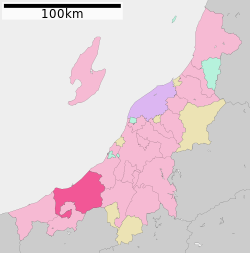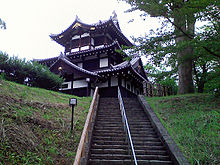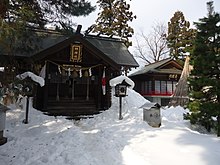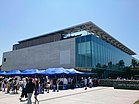This articleneeds additional citations forverification.(October 2016) |
Jōetsu(Thượng việt thị,Jōetsu-shi)is acitylocated inNiigata Prefecture,Japan.As of 1 December 2020[update],the city had an estimatedpopulationof 189,430, in 76,461 households[1]with apopulation densityof 190 persons per km2.The total area of the city was 973.81 square kilometres (375.99 sq mi). Jōetsu borders theSea of Japanand is renowned for its abundance of snow, the annual cherry-blossom festival,sakeandKoshihikaririce.
Jōetsu
Thượng việt thị | |||||||
|---|---|---|---|---|---|---|---|
| |||||||
 Location of Jōetsu in Niigata | |||||||
| Coordinates:37°8′52.3″N138°14′9.9″E/ 37.147861°N 138.236083°E | |||||||
| Country | Japan | ||||||
| Region | Chūbu(Kōshin'etsu) (Hokuriku) | ||||||
| Prefecture | Niigata | ||||||
| First official recorded | 702 AD | ||||||
| Takada city established | September 1, 1911 | ||||||
| Naoetsu city established | June 1, 1954 | ||||||
| Two cities merged and current name | April 30, 1971 | ||||||
| Government | |||||||
| • Mayor | Kanta Nakagawa (since November 2021) | ||||||
| Area | |||||||
• Total | 973.81 km2(375.99 sq mi) | ||||||
| Population (December 1, 2020) | |||||||
• Total | 189,430 | ||||||
| • Density | 190/km2(500/sq mi) | ||||||
| Time zone | UTC+9(Japan Standard Time) | ||||||
| Phone number | 025-526-5111 | ||||||
| Address | 1-1-3 Kida, Jōetsu-shi, Niigata-ken 943-8601 | ||||||
| Climate | Cfa | ||||||
| Website | Official website | ||||||
| Symbols | |||||||
| Flower | Camellia | ||||||
| Tree | Sakura | ||||||




Geography
editJōetsu is in southwest Niigata Prefecture, bordered by theSea of Japanto the north andNagano Prefectureto the south. It is approximately 133 kilometers west of the city ofNiigata,the prefectural capital and 139 kilometers east ofToyama.
Mountains
editSurrounded by theJapanese Alps,Jōetsu contains four noteworthy mountains:
- Hishigatake-yama - part of the Shin-etsu trail and one location of the annual "Candle Road" festival
- Kanayasan - birthplace of skiing in Japan
- Kasugayama - formerly the location ofKasugayama Castle,home of theSengoku perioddaimyō,Uesugi Kenshin
- Yoneyama - a sacred mountain on the border of Joetsu and neighboring Kashiwazaki City
Although part of neighboring cityMyōkō,Mount Myōkōcan also be vividly seen from Joetsu. Known for its heavy snowfall and ski resorts, Mt. Myōkō is listed as one of the100 Famous Japanese Mountains,and is considered the "Mount Fujiof Echigo ".
Surrounding municipalities
edit-
Kasugayama Castel ruins and Jōetsu-shi Maizō Bunkazai center
-
View of central Naoetsu area
-
View of Central Takada area
Climate
editJōetsu has ahumid subtropical climate(Köppen climate classificationCfa). The average annual temperature is 13.4 °C. The average annual rainfall is 2599 mm with January as the wettest month. The temperatures are highest on average in August, at around 26.0 °C, and lowest in January, at around 2.2 °C.[2]
Owing to its coastal location facing onshore winds off the Sea of Japan, Jōetsu is the wettest low-lying part of the northern hemisphere temperate zone apart from theOwaseregion of theKii Peninsula,receiving an average of around 2.8 metres (110.2 in) of precipitation per year. As a comparison,Forkson the windward side ofWashington'sOlympic Peninsulareceives 110 inches (2.79 m) andRizeon the Black Sea coast of Turkey 2,530 millimetres (100 in). The cold winds from the combined power of theSiberian HighandAleutian Lowgive Jōetsu an average of 6.3 metres (250 in) of snowfall that however tends to melt significantly even during the winter. On February 26, 1945, Jōetsu received as much as 3.77 metres (148 in) of snow in one day. The heaviest annual snowfall, since the beginning of regular snowfall measurements in 1953, was 14.94 metres (590 in) in the 1985/1986 season and the heaviest monthly total precipitation 942 millimetres (37 in) in January 1945, whilst the driest month was August 1985 with 16 millimetres (0.63 in).
| Climate data forTakada,Jōetsu (1991−2020 normals, extremes 1922−present) | |||||||||||||
|---|---|---|---|---|---|---|---|---|---|---|---|---|---|
| Month | Jan | Feb | Mar | Apr | May | Jun | Jul | Aug | Sep | Oct | Nov | Dec | Year |
| Record high °C (°F) | 19.4 (66.9) |
21.9 (71.4) |
25.8 (78.4) |
32.3 (90.1) |
33.1 (91.6) |
36.4 (97.5) |
38.9 (102.0) |
40.3 (104.5) |
37.8 (100.0) |
34.1 (93.4) |
28.1 (82.6) |
23.7 (74.7) |
40.3 (104.5) |
| Mean daily maximum °C (°F) | 6.0 (42.8) |
6.7 (44.1) |
10.9 (51.6) |
17.6 (63.7) |
22.7 (72.9) |
25.8 (78.4) |
29.6 (85.3) |
31.3 (88.3) |
27.1 (80.8) |
21.5 (70.7) |
15.5 (59.9) |
9.3 (48.7) |
18.7 (65.6) |
| Daily mean °C (°F) | 2.5 (36.5) |
2.7 (36.9) |
5.8 (42.4) |
11.7 (53.1) |
17.0 (62.6) |
20.9 (69.6) |
25.0 (77.0) |
26.4 (79.5) |
22.3 (72.1) |
16.4 (61.5) |
10.5 (50.9) |
5.3 (41.5) |
13.9 (57.0) |
| Mean daily minimum °C (°F) | −0.4 (31.3) |
−0.8 (30.6) |
1.4 (34.5) |
6.1 (43.0) |
11.6 (52.9) |
16.7 (62.1) |
21.5 (70.7) |
22.6 (72.7) |
18.4 (65.1) |
12.1 (53.8) |
6.1 (43.0) |
1.8 (35.2) |
9.8 (49.6) |
| Record low °C (°F) | −10.7 (12.7) |
−13.2 (8.2) |
−10.3 (13.5) |
−6.5 (20.3) |
−0.4 (31.3) |
6.4 (43.5) |
11.6 (52.9) |
13.0 (55.4) |
8.3 (46.9) |
1.2 (34.2) |
−2.5 (27.5) |
−7.8 (18.0) |
−13.2 (8.2) |
| Averageprecipitationmm (inches) | 429.6 (16.91) |
263.3 (10.37) |
194.7 (7.67) |
105.3 (4.15) |
87.0 (3.43) |
136.5 (5.37) |
206.8 (8.14) |
184.5 (7.26) |
205.8 (8.10) |
213.9 (8.42) |
334.2 (13.16) |
475.5 (18.72) |
2,837.1 (111.70) |
| Average snowfall cm (inches) | 171 (67) |
139 (55) |
47 (19) |
2 (0.8) |
0 (0) |
0 (0) |
0 (0) |
0 (0) |
0 (0) |
0 (0) |
trace | 67 (26) |
413 (163) |
| Average precipitation days(≥ 1.0 mm) | 24.8 | 20.4 | 19.0 | 12.3 | 10.0 | 11.3 | 13.2 | 11.4 | 13.9 | 14.6 | 18.6 | 23.2 | 192.7 |
| Average snowy days(≥ 1 cm) | 19.7 | 17.8 | 8.5 | 0.4 | 0 | 0 | 0 | 0 | 0 | 0 | 0.1 | 9.8 | 56.3 |
| Averagerelative humidity(%) | 79 | 76 | 72 | 67 | 71 | 78 | 81 | 78 | 79 | 78 | 78 | 78 | 76 |
| Mean monthlysunshine hours | 62.4 | 83.2 | 128.7 | 177.6 | 201.8 | 153.6 | 148.4 | 189.6 | 136.7 | 131.8 | 104.1 | 73.0 | 1,591.8 |
| Source:Japan Meteorological Agency[3][4] | |||||||||||||
| Climate data forŌgata,Jōetsu (1991−2020 normals, extremes 1978−present) | |||||||||||||
|---|---|---|---|---|---|---|---|---|---|---|---|---|---|
| Month | Jan | Feb | Mar | Apr | May | Jun | Jul | Aug | Sep | Oct | Nov | Dec | Year |
| Record high °C (°F) | 16.7 (62.1) |
22.7 (72.9) |
24.4 (75.9) |
30.4 (86.7) |
33.4 (92.1) |
34.4 (93.9) |
39.5 (103.1) |
40.0 (104.0) |
39.5 (103.1) |
35.7 (96.3) |
27.4 (81.3) |
23.5 (74.3) |
40.0 (104.0) |
| Mean daily maximum °C (°F) | 6.3 (43.3) |
6.7 (44.1) |
10.1 (50.2) |
15.6 (60.1) |
20.5 (68.9) |
23.9 (75.0) |
28.0 (82.4) |
30.0 (86.0) |
26.3 (79.3) |
20.8 (69.4) |
15.1 (59.2) |
9.5 (49.1) |
17.7 (63.9) |
| Daily mean °C (°F) | 2.9 (37.2) |
3.0 (37.4) |
5.8 (42.4) |
10.9 (51.6) |
16.1 (61.0) |
20.3 (68.5) |
24.4 (75.9) |
26.0 (78.8) |
22.1 (71.8) |
16.4 (61.5) |
10.6 (51.1) |
5.5 (41.9) |
13.7 (56.6) |
| Mean daily minimum °C (°F) | −0.2 (31.6) |
−0.6 (30.9) |
1.5 (34.7) |
6.2 (43.2) |
11.9 (53.4) |
17.0 (62.6) |
21.5 (70.7) |
22.6 (72.7) |
18.4 (65.1) |
12.2 (54.0) |
6.2 (43.2) |
1.9 (35.4) |
9.9 (49.8) |
| Record low °C (°F) | −10.0 (14.0) |
−8.0 (17.6) |
−6.6 (20.1) |
−3.0 (26.6) |
3.2 (37.8) |
9.0 (48.2) |
13.7 (56.7) |
14.2 (57.6) |
8.5 (47.3) |
1.9 (35.4) |
−2.1 (28.2) |
−7.6 (18.3) |
−10.0 (14.0) |
| Averageprecipitationmm (inches) | 293.1 (11.54) |
173.4 (6.83) |
143.5 (5.65) |
93.4 (3.68) |
88.4 (3.48) |
140.3 (5.52) |
208.7 (8.22) |
160.7 (6.33) |
187.0 (7.36) |
180.4 (7.10) |
296.0 (11.65) |
358.0 (14.09) |
2,321.7 (91.41) |
| Average precipitation days(≥ 1.0 mm) | 25.6 | 20.9 | 18.4 | 13.2 | 10.7 | 11.1 | 13.0 | 10.7 | 13.8 | 14.7 | 19.2 | 24.9 | 196.2 |
| Mean monthlysunshine hours | 44.3 | 69.6 | 131.1 | 186.5 | 208.7 | 166.8 | 168.5 | 210.4 | 149.8 | 137.0 | 95.6 | 59.7 | 1,639.8 |
| Source:Japan Meteorological Agency[5][6] | |||||||||||||
| Climate data forNō,Jōetsu (1991−2020 normals, extremes 1978−present) | |||||||||||||
|---|---|---|---|---|---|---|---|---|---|---|---|---|---|
| Month | Jan | Feb | Mar | Apr | May | Jun | Jul | Aug | Sep | Oct | Nov | Dec | Year |
| Record high °C (°F) | 17.5 (63.5) |
22.5 (72.5) |
24.9 (76.8) |
29.6 (85.3) |
30.2 (86.4) |
32.8 (91.0) |
36.5 (97.7) |
36.9 (98.4) |
36.3 (97.3) |
33.5 (92.3) |
26.9 (80.4) |
22.7 (72.9) |
36.9 (98.4) |
| Mean daily maximum °C (°F) | 5.6 (42.1) |
6.0 (42.8) |
9.6 (49.3) |
15.7 (60.3) |
20.8 (69.4) |
23.9 (75.0) |
27.8 (82.0) |
29.4 (84.9) |
25.6 (78.1) |
20.2 (68.4) |
14.5 (58.1) |
8.8 (47.8) |
17.3 (63.2) |
| Daily mean °C (°F) | 2.2 (36.0) |
2.1 (35.8) |
4.9 (40.8) |
10.4 (50.7) |
15.8 (60.4) |
19.8 (67.6) |
23.9 (75.0) |
25.1 (77.2) |
21.1 (70.0) |
15.5 (59.9) |
9.9 (49.8) |
4.8 (40.6) |
13.0 (55.3) |
| Mean daily minimum °C (°F) | −0.6 (30.9) |
−1.1 (30.0) |
1.0 (33.8) |
5.6 (42.1) |
11.1 (52.0) |
16.1 (61.0) |
20.6 (69.1) |
21.6 (70.9) |
17.6 (63.7) |
11.8 (53.2) |
6.0 (42.8) |
1.6 (34.9) |
9.3 (48.7) |
| Record low °C (°F) | −7.3 (18.9) |
−8.1 (17.4) |
−5.8 (21.6) |
−2.2 (28.0) |
2.7 (36.9) |
7.6 (45.7) |
13.4 (56.1) |
14.3 (57.7) |
7.8 (46.0) |
2.6 (36.7) |
−0.5 (31.1) |
−6.1 (21.0) |
−8.1 (17.4) |
| Averageprecipitationmm (inches) | 387.3 (15.25) |
233.3 (9.19) |
208.1 (8.19) |
136.8 (5.39) |
124.6 (4.91) |
174.3 (6.86) |
243.4 (9.58) |
237.9 (9.37) |
281.9 (11.10) |
293.6 (11.56) |
404.4 (15.92) |
474.4 (18.68) |
3,223.5 (126.91) |
| Average snowfall cm (inches) | 204 (80) |
181 (71) |
62 (24) |
2 (0.8) |
0 (0) |
0 (0) |
0 (0) |
0 (0) |
0 (0) |
0 (0) |
0 (0) |
72 (28) |
505 (199) |
| Average precipitation days(≥ 1.0 mm) | 25.2 | 20.1 | 18.9 | 13.1 | 11.5 | 12.1 | 14.5 | 11.5 | 14.8 | 15.8 | 19.2 | 23.9 | 200.6 |
| Average snowy days(≥ 3 cm) | 16.4 | 15.7 | 6.5 | 0.2 | 0 | 0 | 0 | 0 | 0 | 0 | 0.1 | 6.6 | 45.5 |
| Mean monthlysunshine hours | 41.3 | 70.3 | 118.9 | 175.2 | 198.5 | 142.7 | 140.0 | 185.8 | 129.2 | 126.9 | 96.7 | 57.2 | 1,478.3 |
| Source:Japan Meteorological Agency[7][8] | |||||||||||||
| Climate data forYasuzuka,Jōetsu (1991−2020 normals, extremes 1978−present) | |||||||||||||
|---|---|---|---|---|---|---|---|---|---|---|---|---|---|
| Month | Jan | Feb | Mar | Apr | May | Jun | Jul | Aug | Sep | Oct | Nov | Dec | Year |
| Record high °C (°F) | 16.9 (62.4) |
19.8 (67.6) |
25.8 (78.4) |
31.0 (87.8) |
31.4 (88.5) |
34.0 (93.2) |
37.6 (99.7) |
37.6 (99.7) |
36.7 (98.1) |
32.9 (91.2) |
26.0 (78.8) |
21.7 (71.1) |
37.6 (99.7) |
| Mean daily maximum °C (°F) | 4.0 (39.2) |
4.8 (40.6) |
8.6 (47.5) |
15.7 (60.3) |
21.6 (70.9) |
24.6 (76.3) |
28.1 (82.6) |
29.8 (85.6) |
25.7 (78.3) |
19.8 (67.6) |
13.8 (56.8) |
7.3 (45.1) |
17.0 (62.6) |
| Daily mean °C (°F) | 0.6 (33.1) |
0.6 (33.1) |
3.2 (37.8) |
9.3 (48.7) |
15.5 (59.9) |
19.6 (67.3) |
23.6 (74.5) |
24.7 (76.5) |
20.6 (69.1) |
14.5 (58.1) |
8.5 (47.3) |
3.1 (37.6) |
12.0 (53.6) |
| Mean daily minimum °C (°F) | −2.3 (27.9) |
−2.9 (26.8) |
−1.0 (30.2) |
3.7 (38.7) |
9.8 (49.6) |
15.2 (59.4) |
19.9 (67.8) |
20.7 (69.3) |
16.6 (61.9) |
10.3 (50.5) |
4.2 (39.6) |
−0.1 (31.8) |
7.8 (46.1) |
| Record low °C (°F) | −10.9 (12.4) |
−11.0 (12.2) |
−9.0 (15.8) |
−4.5 (23.9) |
1.1 (34.0) |
5.4 (41.7) |
12.7 (54.9) |
12.8 (55.0) |
6.0 (42.8) |
1.3 (34.3) |
−2.6 (27.3) |
−8.5 (16.7) |
−11.0 (12.2) |
| Averageprecipitationmm (inches) | 387.3 (15.25) |
229.5 (9.04) |
172.8 (6.80) |
114.1 (4.49) |
109.3 (4.30) |
150.0 (5.91) |
213.4 (8.40) |
194.0 (7.64) |
202.9 (7.99) |
207.8 (8.18) |
286.5 (11.28) |
411.5 (16.20) |
2,696.3 (106.15) |
| Average snowfall cm (inches) | 293 (115) |
236 (93) |
125 (49) |
13 (5.1) |
0 (0) |
0 (0) |
0 (0) |
0 (0) |
0 (0) |
0 (0) |
2 (0.8) |
134 (53) |
799 (315) |
| Average precipitation days(≥ 1.0 mm) | 25.4 | 21.1 | 19.6 | 14.1 | 11.5 | 12.0 | 14.5 | 11.8 | 14.9 | 15.4 | 18.1 | 22.9 | 201.3 |
| Average snowy days(≥ 3 cm) | 19.9 | 17.6 | 13.4 | 2.0 | 0 | 0 | 0 | 0 | 0 | 0 | 0.3 | 9.7 | 62.9 |
| Mean monthlysunshine hours | 42.2 | 61.8 | 107.9 | 163.7 | 193.7 | 142.1 | 136.8 | 181.4 | 129.3 | 126.8 | 101.3 | 61.1 | 1,444.1 |
| Source:Japan Meteorological Agency[9][10] | |||||||||||||
Demographics
editPer Japanese census data,[11]the population of Jōetsu has declined over the past 60 years.
| Year | Pop. | ±% |
|---|---|---|
| 1960 | 234,673 | — |
| 1970 | 217,679 | −7.2% |
| 1980 | 216,320 | −0.6% |
| 1990 | 212,248 | −1.9% |
| 2000 | 211,870 | −0.2% |
| 2010 | 203,899 | −3.8% |
| 2020 | 188,047 | −7.8% |
Toponymy
editThekanjifor Jōetsu combinesThượng"upward",Việt"to surpass" andThị"city", which can be misleading as the city is located in the southwestern part of Niigata Prefecture, closer to Toyama and Nagano Prefectures, as opposed to more northern areas in Niigata. Prior to theMeiji Restoration,Echigo Provincewas divided into three sections. One portion was calledKami Echigo(Thượng việt hậu),which was translated as "Upper Echigo", due its geographical proximity to the capital city of Kyoto. After the establishment of prefectures throughout Japan, the region name was shortened to"Jōetsu"(Thượng việt).When referring to Jōetsu, it could refer to the actual geographical Jōetsu region, which encompasses the cities of Jōetsu,MyōkōandItoigawa,or may simply refer to the city of Jōetsu.[12]
History
editThe area of present-day Jōetsu has been inhabited for thousands of years, and the ruins of numerousJōmon periodandKofun periodsettlements, tombs and fortifications have been found. The area was part of ancientEchigo Province,and the location of theNara periodprovincial capital.During theSengoku period,it was the center of the holdings of theUesugi clanand notablyKasugayama Castlewas the headquarters of the famed warlordUesugi Kenshin.TheUesugi clanwere transferred byToyotomi HideyoshitoAizuand the area later came under theTakada Domainduring theEdo periodTokugawa Shogunate.
In 1614,Matsudaira Tadateru,the 6th son ofTokugawa Ieyasuwas assigned to Echigo Province and ordered the construction ofTakada Castle.The domain was later ruled by a number offudai daimyōhouses. The lastdaimyōof Takada Domain wasSakakibara Masataka,who sided with the imperial forces in theBoshin Warof theMeiji restorationand who subsequently served as imperial governor until theabolition of the han systemin 1871 by theMeiji government.
The towns of Takada and Naoetsu were created with the establishment of the modern municipalities system on April 1, 1889. Takada was elevated to city status on September 1, 1911 and Naoetsu on June 1, 1954. Takada and Naoetsu merged to form the city of Jōetsu in 1971.
On January 1, 2005, Jōetsu annexed 13 neighbouring municipalities, expanding its area by four times. The municipalities that were annexed into consisted of the following: the town ofYasuzuka,the villages ofMaki,ŌshimaandUragawara(all fromHigashikubiki District); the towns ofItakura,Kakizaki,ŌgataandYoshikawa,and the villages ofKiyosato,Kubiki,NakagōandSanwa(all fromNakakubiki District); and the town of andNadachi(fromNishikubiki District).[13][14]On April 1, 2007, Jōetsu attainedSpecial citystatus, which gives it greater local autonomy from the prefectural government.
Skiing in Japan
editThe victory in theRusso-Japanese Warin 1905 brought about newfound interest in Japanesemilitary strategywhich prompted European powers to send troops to Japan to study new methods of combat. One of the soldiers, anAustro-Hungarianmajor namedTheodor von Lerch,made a profound difference to the Jōetsu locals as well as the nation itself by introducing the sport ofskiingto Japan. On January 12, 1911, Lerch began his ski training on Mt. Kanaya. The participants consisted of both soldiers and civilians. Lerch taught using the "Stemboggen" method, which involved a single bamboo pole that served a dual purpose as a steering tool and as a brake. With the translation help of theIJA 13th DivisioncommanderGaishi Nagaoka,the Takada Ski Club eventually amassed over 6,000 members in 1912. Soon after, skiing spread across the nation, especially in areas where snow dominated the landscape. It provided a new mode of transportation not only for the military, but for those who were rendered immobile by the seemingly impassible slopes of white. To commemorate his contribution, the Japan Ski Origins Museum was erected on Mt. Kanaya in time to coincide with the 80th anniversary of skiing's inception in Japan.[15]
World War II
editDuring World War II, the city of Naoetsu was the site of a POW camp that garnered international focus from the best-selling biography,Unbroken: A World War II Story of Survival, Resilience, and RedemptionbyLaura Hillenbrand[16]and later, the movie adaptation,"Unbroken"in 2014. The book and movie focus on former Olympic track starLouis Zamperiniand the brutal mistreatment of him and his fellow soldiers at the hands of the Imperial Japanese Army corporal,Mutsuhiro Watanabe,infamously known as "The Bird". According to the book, Watanabe fled Naoetsu after the Allied forces invaded Japan and was never charged, despite being one of GeneralDouglas MacArthur's top 40 most-wantedwar criminals.
The Naoetsu POW camp also housed over 300 Australian soldiers, 60 of which died from sickness and poor living conditions. In October 1995, fifty years following the end of the war, the Peace Memorial Park and Peace Statues were founded and built by Jōetsu to promote peace and friendship. The following year, the Japan-Australia Society of Jōetsu was established with the purpose of educating future generations and maintaining a lasting relationship with Australian citizens abroad and living throughout Joetsu.[17]
Government
editJōetsu has amayor-councilform of government with a directly elected mayor and aunicameralcity legislature of 32 members. The city contributes five members to the Niigata Prefectural Assembly. In terms of national politics, the city is part of theNiigata at-large districtin theupper houseof theNational Dietof Japan, andNiigata 6th Districtin thelower house.
Economy
editJōetsu is a regional commercial and industrial centre, with heavy industry concentrated around the port of former Naoetsu, and light manufacturing and commerce around the former Takada area. TheJōetsu Thermal Power Stationis an LNG-firedthermal power stationoperated byJERAin the city.
Education
editColleges and universities
edit- Joetsu University of Educationis a national university established on October 1, 1978, and specializes in pedagogical training for prospective roles in elementary and secondary education, as well as a focus on child growth and development. Although the university accepts international students, the admission rate hovers between 20 and 30%, making it a selective institution.[18]
- Niigata College of Nursing
Primary and secondary education
editJōetsu has 50 public elementary schools and 22 public junior high schools operated by the city government, one public elementary school and one junior high school operated by the national government. The city has eight public high schools, Joetsu High School and Sekine Gakuen High School, operated by the Niigata Prefectural Board of Education and two private high schools. The prefecture also operates four special education schools.
Transportation
editRailway
editHokuetsu Express Hokuhoku Line
Echigo Tokimeki Railway-Myōkō Haneuma Line
Echigo Tokimeki Railway-Nihonkai Hisui Line
Highway
edit- Hokuriku Expressway
- Jōshin-etsu Expressway
- National Route 8
- National Route 18
- National Route 253
- National Route 350
- National Route 403
- National Route 404
- National Route 405
- National Route 460
Ferry
editThe port of Ogi, onSado Island,can be accessed by ajetfoilthat runs 1-3 times a day from March 1 until November 15.
Local attractions
editPlaces of interest
edit- Iwanohara Vineyard Co., Ltd.: one of the oldest wineries in Japan and birthplace of the grape Muscat Bailey A
- Izumi Jomon Park: home to ruins from Japan'sJōmon Period[19]
- Gangi Dori: 16 km alleyway of wooden eaves built to shelter pedestrians during heavy snowfall
- Hida Sites,Yayoi period settlement ruins, National Historic Site
- Joetsu Aquarium Umigatari
- Kasugayama Castle:A castle ruin, main castle ofUesugi clan
- Samegao Castle:A castle ruin of Uesugi clan.
- Takada Castle:Three-story turret located in Takada Park
- Takahashi Magozaemon Shouten: oldest-running candy store in Japan
Cultural events
edit- Candle Road[20]
- Echigo Kenshin Sake Festival
- Joetsu Festival
- Joetsu Lotus Festival
- Kenshin Festival
- Lerch Festival
- Takada Castle Million-Visitor Cherry Blossom Festival
Sister cities
edit- Hunchun,Yanbian Korean Autonomous Prefecture,Jilin,China
- Lilienfeld,Austria
- Pohang,North Gyeongsang,South Korea
Notable people from Jōetsu
edit- Nana Haruta,manga artist
- Maejima Hisoka,politician, businessman, founder of the Japanese Postal System
- Uesugi Kenshin,daimyō
- Ogawa Mimei,children's writer
- Nobutaka Tsutsui,politician
- Kenkichi Yoshizawa,diplomat
- Kawakami Zenbei, winemaker, founder of Iwanohara Vineyard
References
edit- ^"Jōetsu city official statistics"(in Japanese).
- ^Jōetsu climate data
- ^Bình niên trị ( niên ・ nguyệt ごとの trị ).Japan Meteorological Agency.Retrieved2011-11-26.
- ^Quan trắc sử thượng 1~10 vị の trị ( niên gian を thông じての trị ).Japan Meteorological Agency.Retrieved2011-11-26.
- ^Quan trắc sử thượng 1~10 vị の trị ( niên gian を thông じての trị ).JMA.RetrievedMarch 24,2022.
- ^Khí tượng sảnh / bình niên trị ( niên ・ nguyệt ごとの trị ).JMA.RetrievedMarch 24,2022.
- ^Quan trắc sử thượng 1~10 vị の trị ( niên gian を thông じての trị ).JMA.RetrievedMarch 24,2022.
- ^Khí tượng sảnh / bình niên trị ( niên ・ nguyệt ごとの trị ).JMA.RetrievedMarch 24,2022.
- ^Quan trắc sử thượng 1~10 vị の trị ( niên gian を thông じての trị ).JMA.RetrievedMarch 24,2022.
- ^Khí tượng sảnh / bình niên trị ( niên ・ nguyệt ごとの trị ).JMA.RetrievedMarch 24,2022.
- ^Jōetsu population statistics
- ^リンク tập: Thượng việt địa vực[Joetsu Region Information]. Niigata Prefecture.RetrievedJuly 26,2018.
- ^"Takada jo sanju yagura (Takada Castle Three-story-Turret)".Jōetsu Kanko Navi.RetrievedJune 18,2018.
- ^"Sakaki Shrine".Jōetsu Kanko Navi.RetrievedJune 18,2018.
- ^"Japan Ski Origins Museum".Jōetsu Kanko Navi.RetrievedJune 18,2018.
- ^"Unbroken".laurahillenbrandbooks.RetrievedAugust 2,2018.
- ^"Japan-Australia Society of Joetsu".Japan-Australia Society of Joetsu.RetrievedAugust 2,2018.
- ^"Number of Officials and Staff".Joetsu University of Education.RetrievedJuly 26,2018.
- ^"Sightseeing Spots".Jōetsu Kanko Navi.RetrievedJuly 30,2018.
- ^"Calendar of Events".Jōetsu Kanko Navi.RetrievedJuly 30,2018.
Further reading
edit- "Mount Yoneyama".Gaijin Pot. 10 August 2017.RetrievedJune 18,2018.
External links
edit- Media related toJōetsu, Niigataat Wikimedia Commons
- Official Website(in Japanese)
- Jōetsu Tourism(in Japanese)







